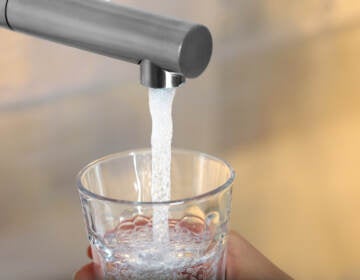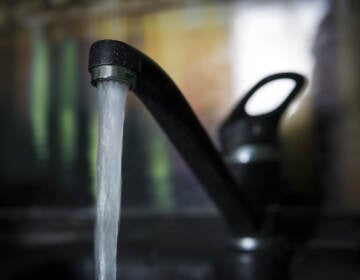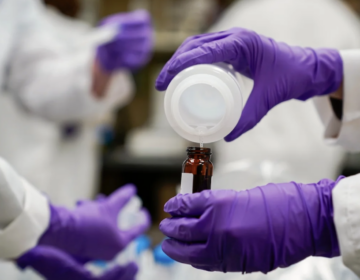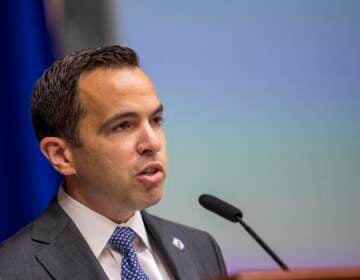EPA proposes first limits on toxic ‘forever chemicals’ for public drinking water
While states like Pennsylvania and New Jersey have already set PFAS limits for public water systems, the EPA proposal is more restrictive and would apply nationwide.
Listen 5:15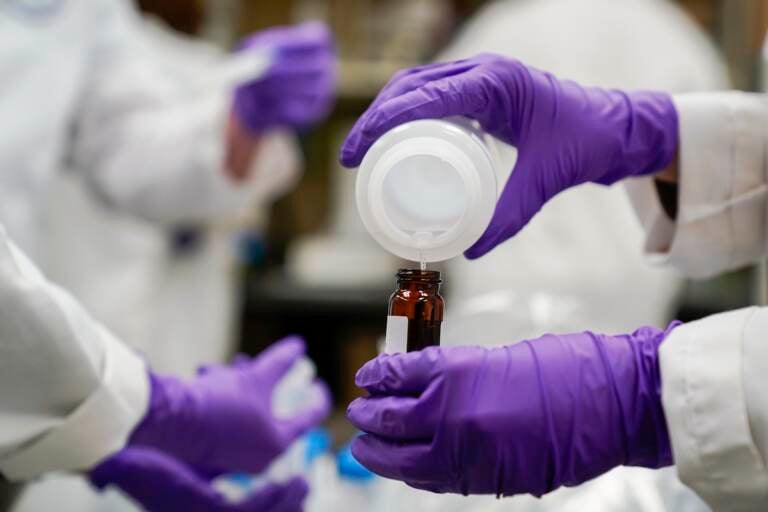
A water researcher pours a water sample into a smaller glass container for experimentation as part of drinking water and PFAS research at the U.S. Environmental Protection Agency Center For Environmental Solutions and Emergency Response, Thursday, Feb. 16, 2023. (AP Photo/Joshua A. Bickel)
The Environmental Protection Agency has proposed its first limits on toxic “forever chemicals” in public drinking water systems nationwide.
The goal, the agency said, is to address increasing concerns about PFAS, a large class of chemicals used in hundreds of everyday products, and its links to numerous health problems.
“We anticipate that when fully implemented, this rule will prevent thousands of deaths and reduce tens of thousands of serious PFAS-related illnesses,” said EPA Administrator Michael Regan, during a Tuesday press conference in Wilmington, N.C., where the chemical company DuPont contaminated nearby waterways with PFAS.
PFAS chemicals have tainted the water, air, and soil across the country for decades. The chemicals have been widely used in consumer products like nonstick cookware, flame-retardant fabrics, and some food packaging, as well as in fire suppressing foam. Water supplies in communities located near military bases and airports have been particularly impacted, as fire suppressing foam has contaminated the groundwater.
Bucks and Montgomery County residents who have lived near former and active military bases in Horsham, Warminster and Warrington are now part of a CDC study looking at the health impacts of PFAS exposure from drinking water. Similar studies have taken place in Paulsboro, New Jersey and New Castle, Del.
The EPA has proposed regulating six types of PFAS chemicals. Once the restrictions are implemented, water systems will be required to monitor and treat its water, and inform the public if PFAS levels exceed the EPA’s limits.
The consequences of exposure to PFAS are long-lasting — the compounds can stay in the environment, and the human bloodstream, for years. The chemicals have been linked to some cancers, thyroid disease, ulcerative colitis, developmental delays in children, and other health conditions. That has led to numerous lawsuits against companies that make the products, such as DuPont and its successor companies, and 3M.
“It’s been a long painful journey, for my family, myself and the community,” said environmental advocate Hope Grosse, co-founder of Buxmont Coalition for Safer Water. Grosse grew up across the street from the Naval Air Warfare Center in Warminster. Her father died of brain cancer, and she was diagnosed with melanoma.
“PFAS is forever, and PFAS is deadly, and it doesn’t belong anywhere in our environment, water or soil. My prayer is that everyone is listening and hearing how dangerous this is,” Grosse said. “I’m emotional and thankful to the EPA today, it’s been a very painful and uplifting day for me.”
EPA currently issues a non-enforceable health advisory for PFAS, which was reduced from 70 parts per trillion to almost zero parts per trillion in June 2022. But there are no federal restrictions on the amount of PFAS allowable in drinking water. That has prompted some states, including New Jersey, and most recently, Pennsylvania, to take it upon themselves to implement what are known as maximum contaminant levels, or MCLs.
EPA has proposed setting MCLs for two types of PFAS — PFOA and PFOS — at 4 parts per trillion. The agency said it’s the lowest possible level it can enforce, based on the ability to reliably measure and remove these contaminants from drinking water.
These levels are much lower, and therefore more restrictive, than current regulations in New Jersey and Pennsylvania. New Jersey sets an MCL of 13 parts per trillion for PFOS and 14 parts per trillion for PFOA, while Pennsylvania’s MCL is 14 parts per trillion and 18 parts per trillion, respectively. States will be required to establish standards that are as strict as the federal rule, and will have up to two years to develop regulations after the rule is final.
As of Tuesday, 95 water providers in New Jersey had at least one PFAS MCL violation, a spokesperson for the state said in an email. She said at least three to four times the number of New Jersey water systems would have exceedances of EPA’s proposed new MCLs, as compared to New Jersey’s current MCLs.
Delaware has proposed implementing MCLs similar to that of Pennsylvania’s. That proposal will not move forward, and instead, the state will follow EPA guidance, a spokesperson for the Delaware Division of Public Health said in an email.
Tracy Carluccio, deputy director of the environmental advocacy group Delaware Riverkeeper Network, said she’s “wholeheartedly” supportive of the proposal.
“They haven’t adopted MCLs or proposed drinking water standards for decades, and the toxicity of PFAS, the prevalence in our communities, and the fact that so many peoples’ drinking water is contaminated, really requires them to finally take this step,” she said. “Under this new administration, we have great hope that this proposal will actually be approved and implemented.”
Carluccio said she wishes the process for approval would be faster.
EPA will hold a public comment period, and finalize the rule by the end of 2023. Once the rule is finalized, water systems will have three years to comply.
Private water wells aren’t regulated by state or federal agencies, however, so they will not have to comply with the regulations.
EPA also wants to limit any mixture containing one or more of PFNA, PFHxS, PFBS, and/or GenX Chemicals. For these PFAS, water systems would use a “hazard index calculation” to determine if the combined levels of these PFAS pose a potential risk. New Jersey already has an MCL for PFNA, but the EPA’s proposal for the chemical would be slightly more restrictive.
The high costs of filtering PFAS
The treatments aren’t cheap. The small town of Willingboro, NJ is building a $5 million treatment system for its water system after testing, just recently required by New Jersey, found levels above the state’s limits. The source of Willingboro’s PFAS remains unknown. The EPA said the Bipartisan Infrastructure Law, which is investing $9 billion in reducing PFAS contamination, will help communities pay for treatment systems.
Water supplier Aqua, which serves 32 counties across Pennsylvania and 11 counties in New Jersey, already samples for PFAS, and sets its own standard at 13 parts per trillion, said Colleen Arnold, president of the Aqua division of Essential Utilities, Inc. Aqua also is publishing its sampling data on its website, so customers know what’s in their water. The most prevalent PFAS chemicals detected in its supply are PFOA and PFOS, because of the use of fire fighting foam.
“It’s been a long time coming,” Arnold said of the EPA’s announcement. “We’ve been waiting for the EPA regulation for years. We’ve been operating in a vacuum, knowing there are public health risks, and trying to stay ahead of it for our customers. [We’re] grateful that EPA has finally stepped up and done their job of putting a regulation force.”
She said Aqua has set aside $40 million to install treatment systems in multiple locations — costing about $1 million per treatment system.
Arnold said rates will need to increase to install treatment systems. However, she said Aqua hopes to relieve the burden by securing grant funding. The company also is involved in a lawsuit against the chemical manufacturers, in hopes of receiving settlement money.
States like Delaware and New Jersey, as well as the city of Philadelphia and other counties, have also sued DuPont and 3M to recover water treatment costs. DuPont agreed to pay the state of Delaware $50 million dollars for PFAS contamination in 2021.
The MCLs are a positive step in the right direction, but water suppliers will need support along the way, said Seetha Coleman-Kammula, president and executive director of PFAS Solutions in New Castle, Del., which has been researching, testing and developing methods to treat PFAS.
Her company also helps water providers by testing its water supplies for PFAS, and measuring the chemicals against six different filter products to determine which is most effective.
Detection systems and treatment systems are readily available, Coleman-Kammula said. However, water suppliers must work harder to reduce their PFAS levels, because it will require them to change their filter products more frequently. Also, the methods used to filter PFAS from drinking water use activated carbon, the production and disposal of which releases large amounts of climate warming CO2.
In Delaware, the rivers and creeks that provide drinking water don’t meet the proposed standard for PFAS prior to being treated, Coleman-Kammula said.
“In the longer term, there’s a need for treatment technologies that are not so expensive, and can get the levels down to 4 PPT” she said.
WHYY is your source for fact-based, in-depth journalism and information. As a nonprofit organization, we rely on financial support from readers like you. Please give today.



